1. Introduction - Package
MSI FX5950 Ultra - Page 1
Introduction - Package
 MSI
is one of the largest manufacturers of NVIDIA chipset based graphics
cards. We will be testing MSI's latest product from the FX family, the FX5950
Ultra
VTD256. At the same time, we will be comparing it to the state-of-the-art
ATI X800XT, since the two cards cost approximately the same amount of money.
So
the question we are about to answer is not which is the best video card but
how big the generation gap between the two target cards is.
MSI
is one of the largest manufacturers of NVIDIA chipset based graphics
cards. We will be testing MSI's latest product from the FX family, the FX5950
Ultra
VTD256. At the same time, we will be comparing it to the state-of-the-art
ATI X800XT, since the two cards cost approximately the same amount of money.
So
the question we are about to answer is not which is the best video card but
how big the generation gap between the two target cards is.
Our first impression of the MSI FX5950 Ultra was "absolutely fantastic".
MSI ships the card in a huge glossy box, picturing what seems to be
a gladiator on the front, besides some stickers with some of its basic features
such as the 256Mb DDR. Opening the cardboard cover on the front of the box,
we
took a first glance at the card's sunflower shaped cooling system and an extended
list of
details
for
the FX5900 architecture.
The back side of the box ushered us in what we were about to
see inside the box: MSI's excellent bundle. Believe it or not, the bundle includes
10 disks in two portable plastic cases. Five of them for gamers and another
five for the regular computer user. Here's a list of the software you get:
Software Bundle
- Tom Clancy's Ghost Recon
- Duke Nukem: Manhattan Project
- The Elder Scrolls III: Morrowind (Installation disk & Construction Set disk)
-
7 in 1 Game Demo Collection
- MSI Media Center Deluxe II
- Photoshop Album SE & 3D-Album LE 2.03
- Virtual Drive Professional & RestoreIT! Professional
- InterVideo WinDVD 5.1 Channel & Supreme Forteign Language Learning Machine
- MSI Multimedia Beyond 3D ( Drivers & Utilities)

Also included is a really handy notebook (the sort
you jot messages in) and the user guide, both decorated
with the same gladiator theme as the box cover.
We
were happy
to
see
an extra
4-pin molex power cable in the box that will make up for the power
connection the card draws on from the PC power supply in order to
function correctly. Finally, a DVI-I/VGA adapter, an S-to-S TV_Out cable,
a 4-port
VIVO cable
and an MSI
computer
case sticker complete the bundled set of goodies.
No doubt MSI's bundle is excellent and will satisfy even the
grouchiest of users.
Of course the card itself is what matters the most, but a nice
bundle is always welcome and can provide an extra dose of enthusiasm
with the recently bought hardware.
To discuss this card further
or to discuss it with other users, go to our forum.
2. A closer look
MSI FX5950 Ultra - Page 2
A closer look
The MSI FX5950 Ultra, as we mentioned before, has a sunflower
shaped, 2-part radial copper heatsink.
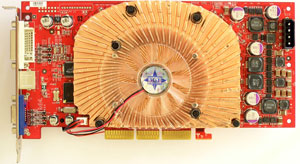
As you can see, MSI continues its tradition with VGA cards, using a red
PCB.
On the front side of the card, there's a white, semi-transparent
fan that takes in cold air and spreads it in a sophisticated way across
the card's surface.

On the rear side, there's a similar "Free-boundle" fan
and heatsink to provide the same flow of air over some memory modules.
However, in the event the extra fan and heatsink do not allow for easy
installation of the card on the motherboard, MSI discretely
advises removal of the rear fan and heat-sink. After all, most FX5950 powered
graphics cards don't have a rear heat-sink and it was MSI's decision to
include
it for overclocking purposes,
hence the
characterization as "Free-boundle".
Without much hesitation, we removed both fans to take a more
detailed look at the card's layout.

It seems MSI hasn't changed much of NVIDIA's
original reference board design. Here we can see the DDR memory modules
spread around the FX5950
chipset.

This is how the card looks with the rear heat-sink removed.
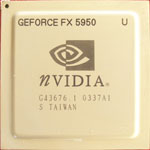
The NV38 chipset is hidden behind nVidia's FX5950 cover which we dared not
remove.
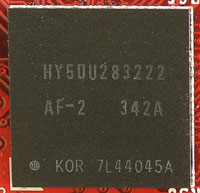
One of the sixteen Hynix DDR memory chips.

On board we found a Philips video encoder/decoder chipset for the Video-In-Video-Out
interface.
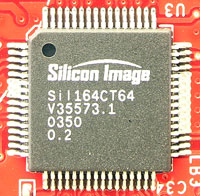
Also a DVI transmitter from Silicon Image.
3. Features
MSI FX5950 Ultra - Page 3
Features
 MSI's Ultra is a typical FX5950 Ultra. It features a 256-bit memory bus for faster data transfer across the board and 256MB of Hynix DDR modules with a latency of 2ns (AF-2).
MSI's Ultra is a typical FX5950 Ultra. It features a 256-bit memory bus for faster data transfer across the board and 256MB of Hynix DDR modules with a latency of 2ns (AF-2).
The default core clock speed is set at 475MHz, like most of the FX5950 Ultra
based cards. The memory clock is also set at 475MHz which creates an effective
speed of 950MHz, a bit below 1GHz.
With 8 pixel pipelines and the ability to render 2 texture units per pipeline,
the card can deliver up to 16 textures per rendering pass. Add to that the
full support for pixel and vertex shader 2.0 code and you have a card able
to produce almost all of today's games high quality effects.
Card Details (as provided by MSI)
256-Bit Advanced Memory Interface
• Wider memory data path with next generation controller technology for superior throughput
NVIDIA CINEFX 2.0 Engine
• Advanced pixel shaders deliver 2x the floating-point pixel shader performance of previous generations.
• Support for Microsoft DirectX 9.0 (DX9) pixel shader 2.0+
• Support for DX9 vertex shader 2.0+
• Long pixel programs up to 1,024 instructions.
• Long vertex programs up to 256 static instructions with up to 65,536 instructions executed.
• Dynamic, conditional execution and flow control.
• Architected for Cg and Microsoft HLSL for maximum compatibility with
next generation content.
• 128-bit, studio-quality, floating-point precision computation through the entire rendering pipeline.
• Native hardware support for 32-bpp, 64-bpp and 128-bpp rendering modes.
• Up to 16 textures per rendering pass.
• Support for sRGB texture format for gamma textures.
• DirectX and S3TC texture compression.
• Optimized for 32-bpp, 24-bpp, 16-bpp, 15-bpp, and 8-bpp modes.
• True-color, 64x64 hardware cursor alpha.
• Multibuffering (double, triple, or quad) for smooth animation and video playback.
Intellisample HCT
• Increased visual quality at higher resolutions through advances in compression, anisotropic filtering, and antialiasing technology.
• Blistering-fast antialiasing and compression performance.
• Support for advanced lossless compression algorithms for both color, texture, and z-data at even higher resolutions and frame rates.
• Fast z-clear
Ultrashadow Technology
• Accelerates shadow volumes for next generation games.
• Accurately maintains shadows while discarding non-useful information
Advanced Display Pipeline With Full NVIDIA NVIEW Capabilities
• Integrated NTSC/PAL TV encoder supporting resolutions up to 1024x768 without the need for panning with built-in Macrovision
copy protection.
• Dual, integrated 400MHz RAMDACs for display resolutions up to and including 2048x1536@85Hz
• Dual DVO ports for interfacing to external TMDS transmitters.
• Internal TV support.
• VIP 1.1 interface support for video-in function.
• Microsoft Video Mixing Renderer (VMR) support for multiple video windows with full video quality and features in each window.
Digital Vibrance control (DVC) 3.0
• DVC image sharpening controls
• DVC color controls
Advanced Technology
• AGP 8X including Fast Writes and sideband addressing
• 0.13-micron process technology for higher levels of integration and higher operating clock speeds
• Advanced thermal management and thermal monitoring
• 40 mmx40 mm, BGA 1309 flip-chip package
4. Test Specifications
MSI FX5950 Ultra - Page 4
Test Specifications
| Processor |
Retail Intel Pentium 4 2.8C |
| CPU Cooler |
Zalman 7000Cu |
| Case |
Antec 1080AMG |
| Motherboard |
ASUS P4C800-E Deluxe (firmware 1014) |
| Memory |
2x256MB OCZ PC-4200EL |
| Hard Disk Drive |
WD800JD 80GB 7200RPM |
| CD-RW |
LiteOn LTR-52246S |
| PowerSupply |
Levicom 500Watt |
| OS |
Microsoft WindowsXP Pro Service Pack1 |
| DirectX |
v9.0b |

Benchmarking Software
3DMark03 Build 340
Codecreatures Benchmark Pro v1.0
AquaMark3 v3.0
GLExcess v1.2
RivaTuner 2.0 RC 14.3
GeForce Tweak Utility
Farcry v1.1 Build 1256
Painkiller v1.15
Unreal Tournament 2003 v2225
Unreal Tournament 2004 v3186
Tomb Raider: Angel of Darkness v49
Halo 1.04 |
5. 3DMark03
MSI FX5950 Ultra - Page5
3DMark03
 3D
Mark is a widely used and accepted benchmark that stress tests the DirectX
performance of a VGA card. For testing the performance of each card, we use
the 4 game
benchmark. The first is a DirectX 7 game, the second and the third
use DirectX 8 and the last one stress tests graphics under DirectX 9. A very
strong point of 3DMark is that its VGA card measurements does not require
any CPU
power. So the resulting fps are a good reference of a VGA card's rendering
performance.
3D
Mark is a widely used and accepted benchmark that stress tests the DirectX
performance of a VGA card. For testing the performance of each card, we use
the 4 game
benchmark. The first is a DirectX 7 game, the second and the third
use DirectX 8 and the last one stress tests graphics under DirectX 9. A very
strong point of 3DMark is that its VGA card measurements does not require
any CPU
power. So the resulting fps are a good reference of a VGA card's rendering
performance.
3Dmark03 also includes sound and CPU tests as well as some other feature
tests. In this page we offer the average FPS for the game benchmarks, having
the MSI 5950 Ultra compared with ATI's X800XT.
- Game Test 1 - Wings of Fury (DX7)
 This test is a combat flight simulator written for older hardware (DirectX 7). Particles are used a lot in this test - smoke and vapor trails, flak and gunfire, and explosions are produced using point sprites and quads.
This test is a combat flight simulator written for older hardware (DirectX 7). Particles are used a lot in this test - smoke and vapor trails, flak and gunfire, and explosions are produced using point sprites and quads.
There are plenty of planes but their polygon frame rate is low, and single
textured background objects are also used. Hence, the average fps (frames per
second)
are high for all cards.
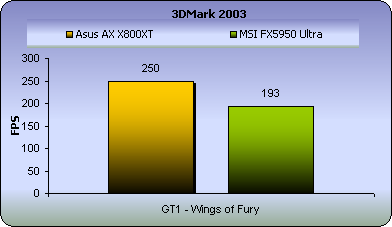
Not bad at all. The FX5950 card can perform reasonably well with DirectX
7.0 at around 70% the performance of the ASUS AX X800.
- Game Test 2 - Battle of Proxycon (DX8)
 This
test is a simulation of first person shooter game types. 1.1 and 1.4 Vertex
shaders are widely used since all character models are skinned using vertex
shaders. This makes this test a good vertex shader comparison for VGA cards.
This
test is a simulation of first person shooter game types. 1.1 and 1.4 Vertex
shaders are widely used since all character models are skinned using vertex
shaders. This makes this test a good vertex shader comparison for VGA cards.

Vertex shaders brought the worst out of the FX5950U, which couldn't even output
half the frames of the ASUS card. Let's see how it runs the
DirectX 8.1 game test, Troll's Lair.
- Game Test 3 - Trolls' Lair (DX8)
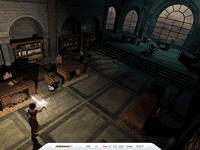 This
test should be the favorite of all RPG lovers. It is a cut scene of a female
warrior facing two malicious trolls. Again, the same vertex and pixel processing
is used as in game test 2.
This
test should be the favorite of all RPG lovers. It is a cut scene of a female
warrior facing two malicious trolls. Again, the same vertex and pixel processing
is used as in game test 2.
This test also uses post-processing effects, such as Depth of Field and Bloom
effects which are widely used in today's game cut scene sequences.
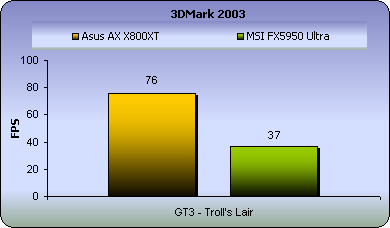
Another devastating result for the FX family. This test is also based on DirectX
8.1 code like Battle of Proxycon but a bit more GPU intensive as you can see.
The X800 outperforms the FX5950 without really trying. However, keep in mind
that 3DMark03 is all about GPU power. Should it have been a real life
game as with the ones
we'll see later on, I think MSI's gladiator wouldn't have had any trouble delivering
decent framerates close to the limit your CPU can handle.
- Game Test 4 - Mother Nature (DX9)
 This game test represents the level of effects and realism that are possible using 2.0 vertex and pixel shaders, plus some other features that DirectX 9 offers.
This game test represents the level of effects and realism that are possible using 2.0 vertex and pixel shaders, plus some other features that DirectX 9 offers.
We've said before that the Radeon series is known to be slightly more capable,
processing vertex and pixel shaders 2.0, according to this test.

No surprises here. The Geforce FX chipsets
are well known for their dramatically low DirectX 9 performance. Let's see
what the final 3DMark03 scores are.
- 3DMark Official score
If you test your machine with 3DMark, you can post the results
at the 3DMark' online result browser. For more information visit futuremark.com.
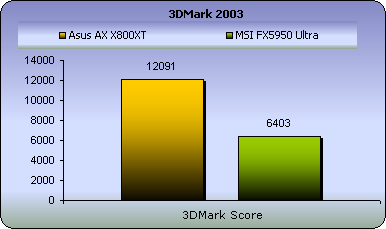
To tell you the truth, I'd be ashamed to post that on the Futuremark website.
The FX5950 can hardly breathe after this struggle with the X800XT.
Is Fx5950 that bad or is the X800XT such a performance monster?
I think a bit of both would be the correct answer. Keep in mind this was an
unfair comparison to start with.
6. Aquamark 3
MSI FX5950 Ultra - Page 6
Aquamark 3
 Since
the majority of today's applications and games are compatible with DirectX
9, the need for benchmark applications that use DX 9 has been brought up.
The benchmark uses the 3D engine (Krass engine) from the Aquanox game.
Since
the majority of today's applications and games are compatible with DirectX
9, the need for benchmark applications that use DX 9 has been brought up.
The benchmark uses the 3D engine (Krass engine) from the Aquanox game.
Unlike synthetic benchmarks, Aquamark3 allows benchmarking in a real-world
scenario with an engine and art assets representing the complexity of current
state-of-the-art games. The results you get from Aquamark vary from a general
result score (AquaMark Triscore), which is a result of 9 chapters each one
utilizing different graphical operations. The AquaMark3 benchmark also delivers
scores for specific hardware components, as well as an overall score for
the entire system.
The chapters that stress the Graphics performance are the following:
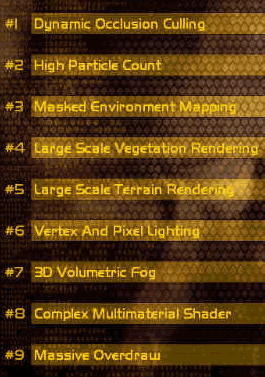
In this section we present comparison charts for the following chapters: High
particle count, Vertex and Pixel Lighting and Massive Overdraw
- High particle count
 This chapter demonstrates a high number of particles being used for simulating dust and smoke. Each particle is approximated by a mass point with one degree of freedom for its rotation.
This chapter demonstrates a high number of particles being used for simulating dust and smoke. Each particle is approximated by a mass point with one degree of freedom for its rotation.
The particle system in this test is designed to render a large number of
natural, accurately simulated particles as efficiently as possible.

Complicated particles in great numbers were a big challenge for previous GPUs
to deal with. But with the latest chipsets released, this is not an issue any
more. And as you can see from the above results, there is a big difference
between
the 2 generations.
- Vertex and pixel lighting
 The
objects in this scene show a broad range of different material and lightning
effects used in modern gaming engines.
The
objects in this scene show a broad range of different material and lightning
effects used in modern gaming engines.
Aquamark3 tests two things: It applies many vertex and pixel shader changes
straining the graphics hardware and its many texture lookups (determining the
lighting contribution and material reflectivity) and also strains the Multitexturing
and rasterization components.

Since the release of the Radeon and FX cards, the Vertex and Pixel lighting
techniques have been used to greater extent, offering a new perspective on
graphics.
This part of the Aquamark benchmark renders complicated lighting effects, the
very
same used in games. We can see excellent performance from MSI's card with only
8 FPS difference from the X800XT.
- Massive Overdraw
 This
scene demonstrates the application of the particle system for large explosions.
The test stresses the graphics hardware with high overdraw of textured
areas, since many particles overlap each other. A huge explosion that is included
in
this chapter, pushes the VGA card to the limits. It's really awesome if you
imagine the number of pixels and shaders needed to make such an explosive
scene.
This
scene demonstrates the application of the particle system for large explosions.
The test stresses the graphics hardware with high overdraw of textured
areas, since many particles overlap each other. A huge explosion that is included
in
this chapter, pushes the VGA card to the limits. It's really awesome if you
imagine the number of pixels and shaders needed to make such an explosive
scene.
This is an important test, because the explosions in games require a lot of
vertex and pixel processing. In many games when an explosion occurs, this causes
frames
to drop suddenly at that particular moment. So this test is a simulation of
what to expect from your card when facing explosions and other similar effects
in games.

- Aquamark Triscore
The Aquamark Triscore comprises 3 values: the overall system performance,
the performance of the graphics system and CPU performance. Keep in mind
that this is not the total result of the above tests, but the result of the
whole benchmark process including all 9 chapters.

The total Triscore for the MSI card is disappointing. 43256 would be
fine for an FX5900XT powered VGA card but not for the Ultra version. We were
expecting much more. Let's move on to the Codecreatures benchmark.
7. Codecreatures
MSI FX5950 Ultra - Page 7
Codecreatures
 Code
Creatures is a synthetic 3D benchmark that is a good reference for VGA performance
comparisons. This is a high-end 3D benchmark that also requires DirectX 8
hardware, making a good tool for measuring the potential of DirectX 8 game
performance.
Code
Creatures is a synthetic 3D benchmark that is a good reference for VGA performance
comparisons. This is a high-end 3D benchmark that also requires DirectX 8
hardware, making a good tool for measuring the potential of DirectX 8 game
performance.
The Code Creatures benchmark is written with Microsoft's DirectX 8.1 API and
incorporates the use of Vertex and PixelShaders, popular on next generation
3D accelerators.
 The
benchmark plays a photo-realistic nature scene and calculates the performance
of the graphics adapter by measuring the fps that it can display at 1024x768,
1280x1024 and 1600x1200 resolutions. The score is a geometric mean of those
three resolutions called the Code Creatures number.
The
benchmark plays a photo-realistic nature scene and calculates the performance
of the graphics adapter by measuring the fps that it can display at 1024x768,
1280x1024 and 1600x1200 resolutions. The score is a geometric mean of those
three resolutions called the Code Creatures number.
For this Benchmark, I grabbed average FPS results for the following resolutions:
1024x768, 1280x1024 and 1600x1200.

The FX5950U did very well here. If Code Creatures is run on a P4 2.8GHz
at 60fps at 1024x768 resolution, compared to the X800's performance, then the
MSI FX5950 Ultra's performance is tolerable at 52fps. At higher resolutions
however, the performance is not satisfactory, especially when compared to the
ASUS AX X800 which remains fairly constant.
- Code Creatures number

The Code Creatures number is the resultant score of the total benchmarking
process which includes some other measurements except for a plain sum up
of the fps results.
MSI's card lags behind the Asus X800XT by a difference of 1550 Code Creature
points. It could have been worse so I'm pretty much satisfied with the result.
8. GLExcess
MSI FX5950 Ultra - Page 8
GLExcess
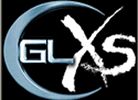 GL
Excess is a very good tool for measuring the performance of VGA cards with
OpenGL applications and games. This benchmark consists of 12 scenes grouped
in 4 categories (3 scenes in 1 category). Each category stress tests different
OpenGL graphical sequences. The overall result named XSMark is the sum of
the first scene of each category. All scenes were run in the 1024x768 resolution
at 32bit.
GL
Excess is a very good tool for measuring the performance of VGA cards with
OpenGL applications and games. This benchmark consists of 12 scenes grouped
in 4 categories (3 scenes in 1 category). Each category stress tests different
OpenGL graphical sequences. The overall result named XSMark is the sum of
the first scene of each category. All scenes were run in the 1024x768 resolution
at 32bit.
- Category 1
 The
first category includes scenes 1, 9 and 12. Nothing specific is stressed in
these scenes. Just average use of general OpenGL techniques.
The
first category includes scenes 1, 9 and 12. Nothing specific is stressed in
these scenes. Just average use of general OpenGL techniques.
The picture you see from scene 12 is made of three shifting and rotating
layers, which are textured in 4 blending modes. Nice effect!

- Category 2
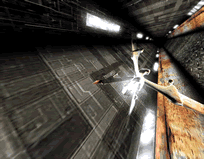 Scenes
3, 5 and 6 stress the card's 3D particle and polygon processing. Particles
are widely used in games and you see them for example when you fire with a
laser beam or when you light up a torch.
Scenes
3, 5 and 6 stress the card's 3D particle and polygon processing. Particles
are widely used in games and you see them for example when you fire with a
laser beam or when you light up a torch.
All 3 scenes are made with a particle system that stresses the card's polygon count and video memory. The spaceship you see in the picture is made of a very large number of polygons
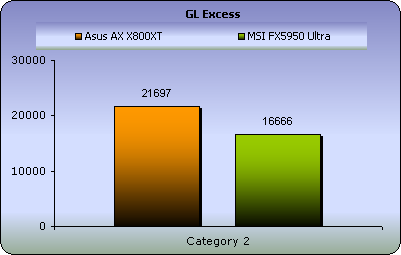
- Category 3
 The
third category sums up scenes 4, 10 and 11 that test the blending ability
of the card. Blending is the mixture of the graphics layers that result in
complicated textures and effects.
The
third category sums up scenes 4, 10 and 11 that test the blending ability
of the card. Blending is the mixture of the graphics layers that result in
complicated textures and effects.
The fill rate of each card is also stressed in these scenes. So this test
should be a reference as to the quality of each card.
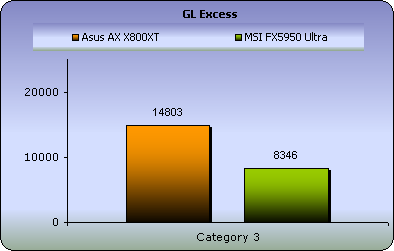
- Category 4
 Scenes
2 and 7 that constitute this category, having to do with multitexturing effects.
Multitexturing is the process of applying two or more textures to a single
polygon or pixel, in order to provide spectacular images.
Scenes
2 and 7 that constitute this category, having to do with multitexturing effects.
Multitexturing is the process of applying two or more textures to a single
polygon or pixel, in order to provide spectacular images.
Scene 8 uses a sphere map that is mixed to a simple texturing technique in
order to give reflection effects. The reflection and shadow effects
you see in games are accumulated in the stencil buffer.

XS Marks
XS Marks is the score of the GL Excess benchmark. Keep in mind that this
score doesn't sum up the results of all 12 scenes but the score
of each category's first scene. The XS Marks you get with your card can be
posted
on the GL Excess web site to compare it with other scores.

The MSI FX5950 Ultra comes up with an incredible performance in this OpenGL
benchmark. If you check out the Category 4 benchmark for multitexturing effects,
you'll see an unbelievable chart. There, the FX5950U outperformed the Asus
X800XT by a total of 250 marks!
I have to admit I didn't see that coming.
ATI's support for OpenGL code is well known, being well behind, but fortunately
for ATI owners the company is aware of this and has promised a lot of progress
over the following months.
9. Doom 3
MSI FX5950 Ultra - Page 9
Doom 3

Massive demonic invasion has overwhelmed the Union Aerospace Corporations
(UAC) Mars Research Facility leaving only chaos and horror in its wake. As
one of only a few survivors, you struggle with shock and fear as you fight
your way to Hell and back, in an epic clash against pure evil.
Activision made it's miracle again with Doom 3, which is said to be the best-looking
game ever, thanks to the brand-new 3D graphics engine used to generate its
convincingly lifelike, densely atmospheric, and surprisingly expansive environments.
If you are a fan of the previous Doom games, then you will get many flashbacks
with this 3rd edition, since you will find re-conceived versions of
almost every monster from both Doom and Doom II.
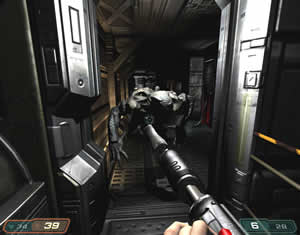
In this test, the framerate is limited by CPU power. But a P4 running
at 2.8GHz is much faster than the CPU of the average game player so you
can rest
assured
that the FX5950U gives you more than you need.

With an average of 50fps at 1024x768 resolution, gameplay is smooth
even in the most demanding scenes.
Let's see what happens when we enable 4x for AA and 8x for AF.

Now things have changed. Sure, gameplay can still be smooth at 45 fps, but
that's for the 800x600 resolution. Increasing it to 1024x768 drops the framerate
to 32 which means that when the scene is full of monsters, it will drop below
25, so play would get irritating after a while as you keep on missing frames.
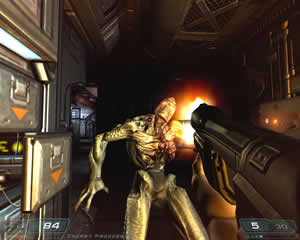
10. Far Cry
MSI FX5950 Ultra - Page 10
Far Cry

 You are Jack Carver running your own boat charter business in beautiful Micronesia. With a past best left behind you, you'll be focusing on your present assignment: escorting an ambitious journalist named Valerie Cortez to the Island of Cabatu. It seems like a piece of cake, but you'll soon learn: paradise can be hell.
You are Jack Carver running your own boat charter business in beautiful Micronesia. With a past best left behind you, you'll be focusing on your present assignment: escorting an ambitious journalist named Valerie Cortez to the Island of Cabatu. It seems like a piece of cake, but you'll soon learn: paradise can be hell.
Farcry is an awesome First Person Shooter (FPS) based on a last generation
3D engine named CryEngine. Real-time editing, bump-mapping, static lights,
network system, integrated physics system, shaders, shadows and a dynamic
music system are just some of the state of-the-art features that the CryEngine
offers.
A great advantage and strong point of the CryEngine is its physics system
which supports character inverse kinematics, vehicles, rigid bodies, liquid,
rag doll, cloth and body effects. All physics seem to be very realistic and
you never get bored when facing enemies, since character models have multiple
animations that blend in very realistic ways.
With an integrated shader system and a massive terrain which maximizes the
viewing distance to 2km, these features make Farcry a perfect action game and
also a referable benchmark to speak of.
- Benchmark Settings
We made our own demo with Farcry for benchmarking the VGA cards. For the
demo we picked the Fort map and positioned the character on the top of the
mountain where the whole island can been viewed at an unbelievable distance
of about
2 kilometers. It's a really stressing benchmark for VGA cards since we used
the high quality settings for all tests. We were careful not to use many bots
because the advanced AI system of the game consumes a lot of CPU power.

The latest patch (1.2) was used for our tests which updates the game's graphics
engine to use the Shader model 3.0. Unfortunately, this is supported for the
6800 series only.
The resolutions we ran the demo under are the following: 1024x768, 1280x1024
and 1600x1200. The first test was conducted with Anti Aliasing (AA)
and Anisotropic Filtering (AF) features off. In the second test, we upped
the AA
level to 4x and
AF to 8x. Keep in mind that this test is the most stressing of our whole
game benchmarks series.
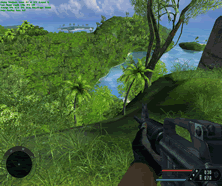
With the 1.2 version of Farcry, the 3D engine has been updated and supports
the latest shader model 3.0 giving an even better visual perception in the
breathtaking natural enviroment of the game.
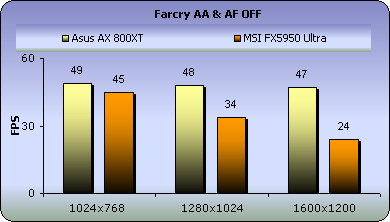
MSI's FX5950 Ultra performs satisfactorily, ensuring that you
get to enjoy this wonderful game with all its optical delites enabled,
which wouldn't happen with an FX5900XT or older card.

First-class performance from the X800. On the other hand, playing with the
FX5950U while having Anti-Aliasing at 4x and Anisotropic Filtering at 8x, gaming
is
too hard or even impossible. It can't keep the FPS counter from dropping below
25fps which is a little disappointing.
11. Unreal Tournament 2004
MSI FX5950 Ultra - Page 11

Unreal Tournament 2004
 Unreal Tournament 2004 is a multiplayer first person shooter that combines the kill-or-be-killed experience of gladiatorial combat with cutting-edge technology.
Unreal Tournament 2004 is a multiplayer first person shooter that combines the kill-or-be-killed experience of gladiatorial combat with cutting-edge technology.
Ten game modes - both team-based and "every man for himself" -- provide even the most hardcore gamer with palm-sweating challenges through unbelievably detailed indoor arenas and vast outdoor environments.
As the ultimate techno-gladiator of the future, players will take their fates into their hands, battling against up to 32 other players online in action-packed, frag-filled arenas
- Unreal Tournament 2004 Benchmark
Many new features and maps are available in Unreal T. 2004. Also, the gameplay
has changed in many of its game types. For example, there is the "Onslaught"
game type where you have to take over the enemy base using war-machines and
vehicles
in a massive map. For this reason, we included an Onslaugh and a Capture The
Flag (CTF) map.
As with the other games, we conducted the benchmark using our time demos in
the 1024x768, 1280x1024 and 1600x1200 resolutions. All tests were done with
the maximum detail settings selected. 2 bots were used on the Ons-Torlan map
and 8 bots on the CTF-Bridge of Fate map. First, let's see the Onslaught game
type test on the Torlan map.
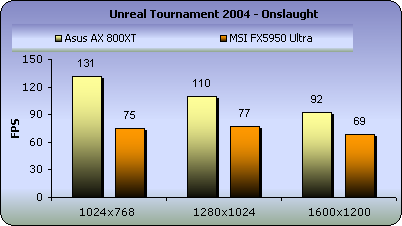
Here, MSI's Ultra managed to keep a low profile but with a stable performance
under all three resolutions.
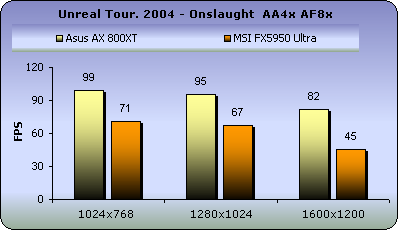
Enabling the Anti-Aliasing and Anisotropic Filtering settings, the FX5950U
keeps the performance above 65 with 1024x768 and 1280x1024, but finally
collapses to 45 when the resolution is upped to 1600x1200. Even though that
is still acceptable, it's almost half the rate of the X800XT.
Except for the Onslaught game type, unreal T. 2004 also has the following
game types: Assault, Deathmatch, Capture the Flag, Team Deathmatch, Double
Domination, Bombing Run, Mutant, Invasion and Last Man Standing. I also used
a Capture the Flag time-demo with the same high quality settings.The CTF map
I picked is the Bridge of Fate with 8 bots.
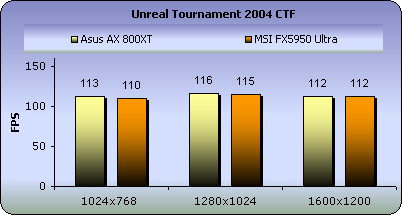
Both cards here performed equally well. With the framerate hovering at
around 110, nothing can prevent you from having a nice Capture the Flag match
with
your buddies. We'll increase the image quality and re-examine the performance.
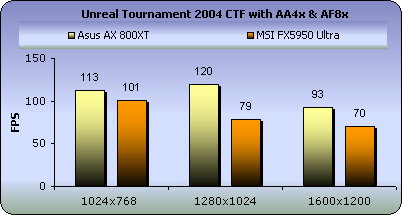
Excellent performance by both cards. With a small decrease of around 8 fps
under 1024x768 and a framerate of 70 at 1600x1200, there's nothing you
can do
to bring the FX5950U to its knees.
12. Hitman Contracts
MSI FX5950 Ultra - Page 12
Hitman Contracts
 Agent 47 is holed up in a hotel somewhere in Paris. He has been shot and is heavily doped up on painkillers. He's in a ghastly state and is both hallucinating and suffering from nightmarish flashbacks. This is where the missions in Hitman: Contracts come into play, as each one is designed to be a flashback to a previous hit from 47's past.
Agent 47 is holed up in a hotel somewhere in Paris. He has been shot and is heavily doped up on painkillers. He's in a ghastly state and is both hallucinating and suffering from nightmarish flashbacks. This is where the missions in Hitman: Contracts come into play, as each one is designed to be a flashback to a previous hit from 47's past.
Every mission in the game uses a structure that's similar to those in
past Hitman games, thus giving you multiple objectives and multiple ways
to achieve them. At his disposal, 47 has more than 30 firearms and a host
of new melee weapons and attacks, including new sneak attacks for stealth
killing.
To be honest, I expected more from the 3rd revision of this
game. Even though I really enjoyed Hitman 1, I found boring and awkward the
next
2 sequels.
But Hitman: Contracts differs from the previous games for its awesome
graphics. You have to play this game to see what I mean. I was staring in awe
those fabulous weather effects, the likes of which I haven't seen
in any other game.
But the real reason I drafted Hitman: Contracts into our benchmark suite
is it's very requiring Post Filtering quality setting. This game uses a unique
post filtering system with complicated blurring effects. And as you can see
for yourselves, it really strains even the latest GPUs making it a very
good benchmark.
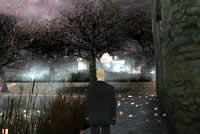
- Benchmarking Settings
Unfortunately, the game doesn't have a decent benchmark process or a demo recording
capability. Thus, I played manually a part of a stage that I found suitable.
The stage is named "Beldingford Manor" and it has very spectacular
rain effects. For the sake of VGA benchmarking, Agent 47 storms at a Scottish
manor eliminating whatever gets in his way.
Firstly, I played the stage in 1024x768, 1280x1024 and 1600x1200 resolutions
without having the quality settings (post filtering, anisotropic) enabled.
I played again the same stage doing the same thing, but this time with Anisotropic
and high Post filtering settings enabled.
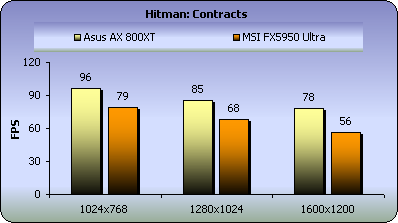
The FX5950 Ultra shows some of its quality in this benchmark. It can even
output quite high fps at 1600x1200 resolution. Compared to the Asus beast,
it's
still close enough, which makes amends for some of the previous tests.
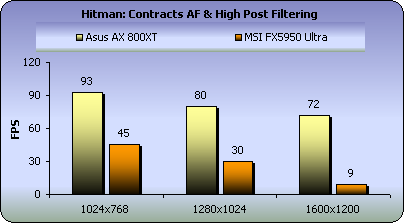
Here, the FX card shows it can keep up and give some good framerates at
1024x768 and 1280x1024. Both playable with average fps of over 25 in contrast
to 1600x1200,
where you can almost count the frames as they refresh on the screen.

13. X2: The Threat
MSI FX5950 Ultra - Page 13
X2: The Threat
 Trade your way through the space lanes and achieve mogul status.
Trade your way through the space lanes and achieve mogul status.
Fight your way through dozens of interlinked missions within an all-new storyline.
Build your empire of stations and ships across the Universe.
Think if your next move could be your last as the Universe reacts to your actions.
A first person space experience designed for today's game players with sound and graphics to match.
Discover new worlds and races, become a trader, bounty hunter, pirate, miner or a cunning combination of them all.
The uneasy peace that befalls the Universe is about to be broken...
Can you meet the Threat head on?
Yes, this game is as good as it sounds. If you enjoyed freelancer, then you
will fall in love with X2: The Threat. Apart for it's vast universe environment,
perfectly suitable for countless space explorations, this game also includes
a very remarkable 3D engine. Also, it's full support of Antiliasing and Anisotropic
filtering settings makes it a good reference for testing the capabilities of
latest generation VGA cards.
For our tests, I used a benchmark of X2 that I found on the net, and believe
me, it is very demanding even for the high-end chipsets currently available.
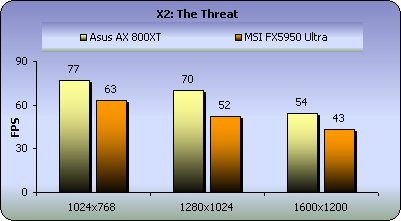
Here, we got similar performance for both cards with the difference between
ranging between 11 up to 18 fps.
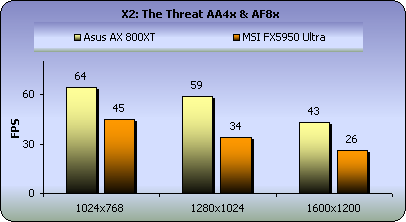
When we increased the quality settings for X2: the threat, we noticed a drop
of exactly 18 fps with the FX5950U. Yet, we're still satisfied since
it never
fell under 25fps.
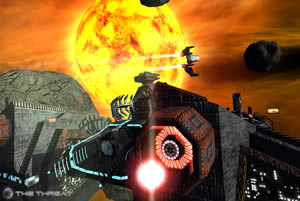
14. Halo
MSI FX5950 Ultra - Page 14
Halo
 Halo
is a sci-fi shooter that takes place on a mysterious alien ring-world. Packed
with combat, Halo will have you battling on foot, and in vehicles, inside
and outdoors with Alien and Human weaponry. Your objective: to uncover Halo's
horrible secrets and destroy mankind's sworn enemy, the Covenant.
Halo
is a sci-fi shooter that takes place on a mysterious alien ring-world. Packed
with combat, Halo will have you battling on foot, and in vehicles, inside
and outdoors with Alien and Human weaponry. Your objective: to uncover Halo's
horrible secrets and destroy mankind's sworn enemy, the Covenant.
The game supports the latest shader technology of pixel shaders 2.0. Of course
the graphics are somewhat better on a PC than an Xbox, since most of the game's
shader effects have been redesigned to support the latest 2.0 shaders in DX9.
Having in mind that there are few games supporting 2.0 pixel shaders, Halo
is a good test for VGA card performance with shader technology.
A prominent disadvantage of the game, is its lack of Anti Aliasing and Anisotropic
Filtering support. If you get the strange idea to enable these settings
via the control panel of your card, you will experience no difference in graphics
quality
as well as slowing things down and losing performance.
- Halo Benchmark
 For
the Halo benchmark, I set the default settings with pixel shaders 2.0 in the
following resolutions: 1024x768, 1280x1024 and the awesome 1600x1200. I used
the time-demo command to execute the default benchmark sequence and here are
the results.
For
the Halo benchmark, I set the default settings with pixel shaders 2.0 in the
following resolutions: 1024x768, 1280x1024 and the awesome 1600x1200. I used
the time-demo command to execute the default benchmark sequence and here are
the results.

On Halo, the X800XT seems almost undisturbed by the successive
increase in resolution, whereas MSI's Ultra drops significantly, just staying
above 25 fps.
Still, gameplay is very smooth with the first 2 resolutions and you'll get
to enjoy every part of the game.
15. Tomb Raider: Angel of darkness
MSI FX5950 Ultra - Page 15
Tomb Raider: Angel of darkness
 A series of grisly murders brings Lara into conflict with a sinister Alchemist from the past, and a secret alliance of powerful individuals shrouded in mystery. Accused of the murder of her one time mentor, Werner Von Croy, Lara becomes a fugitive on the run. Pursued by the police, she follows the Alchemist into a dark world of blood, betrayal and vengeance where it is up to her to defeat this unholy alliance, and stop them from unleashing their incredible powers on the world.
A series of grisly murders brings Lara into conflict with a sinister Alchemist from the past, and a secret alliance of powerful individuals shrouded in mystery. Accused of the murder of her one time mentor, Werner Von Croy, Lara becomes a fugitive on the run. Pursued by the police, she follows the Alchemist into a dark world of blood, betrayal and vengeance where it is up to her to defeat this unholy alliance, and stop them from unleashing their incredible powers on the world.
Angel of Darkness employs a brand new engine with Lara now made up of over 5,000 polygons as opposed to just 500 in previous Tomb Raider games. The range of special effects create a batch of cool visuals.
From the many types of water (mercurial liquid forms, good surface texturing,
and realistic pools of water) to fire (heat blurs and colorful, fiery pits),
to the game's many light effects (lots of shadowing, multiple light sources
and effective reflections), Core mixes more realistic settings with special
effects to create a well-rounded whole. It is worth mentioning though that
Tomb Raider: AOD, uses pixel shader 2.0 technology to a higher extent than
Halo does.
- Tomb Raider:AOD Benchmark
I recorded a time-demo on the Paris stage. The particular scene where the
time-demo was recorded, is full with complicated fire effects. This benchmark
stresses a lot the cards pixel shading processes and I believe it is the most
stressful pixel shader 2.0 game benchmark.

We grabbed the fps from the time-demo twice. Once with the Anti Aliasing and
Anisotropic Filtering off (Trilinear was used instead), and once more with
AA at 4x and Anisotropic Filtering mode enabled from the game's settings console.

The game is only playable under 1024x768 with the FX5950 which shows how badly
it processes pixel shader 2.0 effects. Let's see if it can keep that above
25
fps with 4x Anti-Aliasing and 8x Anisotropic Filtering.
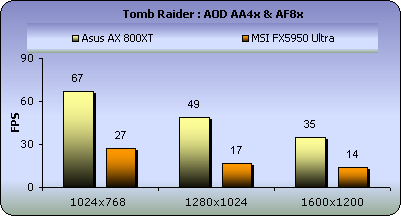
Yes it did, barely. 27 fps might not be enough to enjoy playing the game,
but then again you can opt out some quality settings like turning
off AA and choosing 8x for AF.
16. Overclocking
MSI FX5950 Ultra - Page 16
Overclocking
The MSI FX5950 Ultra edition isn't much of an overclocker. It's
not that we didn't get the clocks to run much faster, but the difference we
got in Doom 3 and Far Cry benchmarks was not so great. Using RivaTuner, we
pushed the core speed from 475MHz to 540MHz and the memory clock from 950MHz
to 1.04GHz.
Let's see the results:
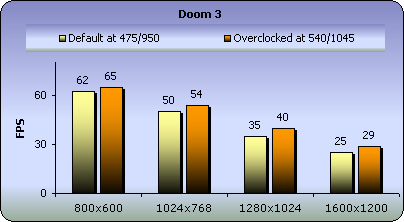
Doom 3 got a boost of around 4 frames per second
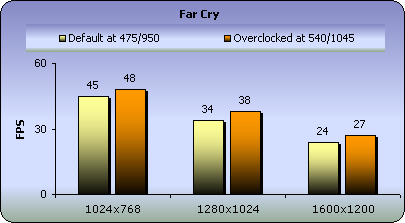
Far Cry performance improved by 3fps.
I knew the memory would go beyond 1GHz but I had a false hope
that suddenly the FX5950U would surprise us somehow by being a really good
overclocker. Instead, whenever I set the clocks higher than 540MHz and 1.04GHz,
the card would
get unstable and lock up the system for some time (indicating a way too high
core speed) or produce artifacts (too fast a memory clock).
I guess the flower-like heatsinks that are provided, do not do
such a good job, other than keeping the card cool only at the predefined
range of frequencies, which is fair enough. However, it makes up for it
by being an ultra-quiet solution.We
have to give credit to MSI for that. Even though the computer case that we
ran our tests on was open all the time, we couldn't discern any noise
at all
coming
from
the AGP card.
17. Conclusion
MSI FX5950 Ultra - Page 17
Conclusion

The generation gap between the MSI FX5950 Ultra and the new generation graphics cards is obviously huge. The FX product line reached a dead end and now the future belongs to Geforce 6 for NVIDIA.
MSI's FX5950U simply doesn't justify the amount of money it costs (around
$450) when compared to a product with an FX5900XT chip on board.
However, it's still a very good graphics card that can probably deliver
more than your computer can handle on some of the most popular games.
Sure, the packaging is nice and the software bundle is very impressive,
but let's face it: when the user is looking to buy a new VGA card, he wants
to get the most bang for his buck and the FX5950 Ultra is really not
worth as much as it costs.
To discuss this card further or to discuss
it with other users, go to our forum.